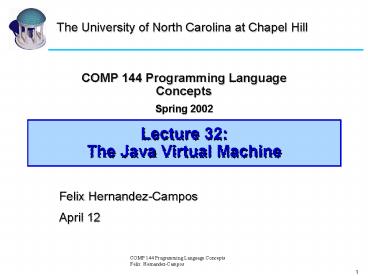COMP 144 Programming Language Concepts PowerPoint PPT Presentation
Title: COMP 144 Programming Language Concepts
1
Lecture 32The Java Virtual Machine
The University of North Carolina at Chapel Hill
- COMP 144 Programming Language Concepts
- Spring 2002
Felix Hernandez-Campos April 12
2
The Java Virtual Machine
- Java Architecture
- Java Programming Language
- Java Virtual Machine (JVM)
- Java API
- We will use the JVM as a case study of an
intermediate program representation
3
Reference
- The content of this lecture is based on Inside
the Java 2 Virtual Machine by Bill Venners - Chapter 1Introduction to Java's Architecture
- http//www.artima.com/insidejvm/ed2/ch01IntroToJav
asArchitecturePrint.html - Chapter 5 The Java Virtual Machine
- http//www.artima.com/insidejvm/ed2/ch05JavaVirtua
lMachine1.html - Interactive Illustrations
- http//www.artima.com/insidejvm/applets/index.html
4
The Java Programming Environment
5
The Java Platform
- The byte code generated by the Java front-end is
an intermediate form - Compact
- Platform-independent
6
Phases of Compilation
7
The Role of the Virtual Machime
Local or Remote
8
The Execution Engine
- Back-end transformation and execution
- Simple JVM byte code interpretation
- Just-in-time compiler
- Method byte codes are compiled into machine code
the first time they are invoked - The machine code is cached for subsequent
invocation - It requires more memory
- Adaptive optimization
- The interpreter monitors the activity of the
program, compiling the heavily used part of the
program into machine code - It is much faster than simple interpretation
- The memory requirement is only slightly larger
due to the 20/80 rule of program execution (In
general, 20 of the code is responsible for 80
of the execution)
9
The Java Virtual Machine
10
Shared Data Areas
11
Thread Data Areas
Frame in Execution
12
Stack Frames
- Stack frames have three parts
- Local variables
- Operand stack
- Frame data
13
Stack FrameLocal Variables
class Example3a public static int
runClassMethod(int i, long l, float f, double d,
Object o, byte b) return 0
public int runInstanceMethod(char c, double d,
short s, boolean b) return 0
14
Stack FrameOperand Stack
Adding 2 numbers iload_0 iload_1 Iadd istore_2
15
Execution Model
- Eternal Math Example
- http//www.artima.com/insidejvm/applets/EternalMat
h.html
16
Stack FrameFrame Data
- The stack frame also supports
- Constant pool resolution
- Normal method return
- Exception dispatch
17
Stack FrameFrame Allocation in a Heap
class Example3c public static void
addAndPrint() double result
addTwoTypes(1, 88.88) System.out.println(
result) public static double
addTwoTypes(int i, double d) return i
d
18
Stack FrameNative Method
- A simulated stack of the target language (e.g. C)
is created for JNI
19
The Heap
- Class instances and array are stores in a single,
shared heap - Each Java application has its own heap
- Isolation
- But a JVM crash will break this isolation
- JVM heaps always implement garbage collection
mechanisms
20
HeapMonolithic Object Representation
21
The HeapSplitted Object Representation
22
Example
- HeapOfFish
- http//www.artima.com/insidejvm/applets/HeapOfFish
.html
23
The HeapMemory/Speed Tradeoff
24
The HeapArrays as Objects
25
Reading Assignment
- Inside the Java 2 Virtual Machine by Bill Venners
- Ch 1
- Ch 5
- Illustrations

